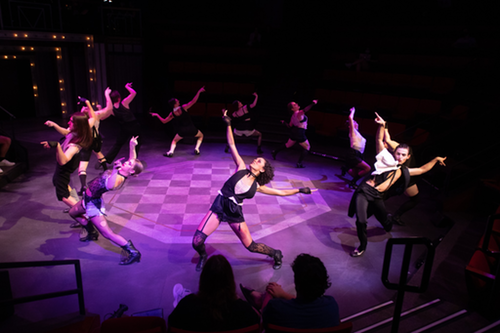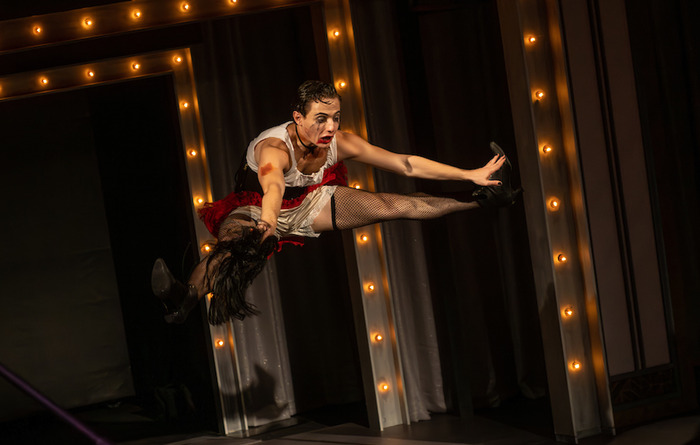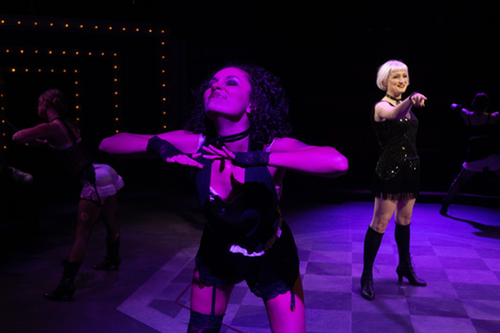
On a mid-December evening in 1966, as I walked down the aisle to my mezzanine seat in the third row of the Broadhurst Theatre in New York to see one of the first performances of the musical Cabaret, I was struck by my image reflected by a huge convex mirror stage. The closer I got to the stage, the more I was confronted by my grotesque self getting larger, longer, and out of proportion.
Little did I know at the time that out-of-focus image was reflecting the concept of the era being depicted in the story. Yes, it was the time of the growth of the Nazi Party, the rise of Hitler, the creation of concentration camps, and the destruction of much of the Jewish/Gay/Gypsy/ Communist/disabled populations of eastern Europe.
Yes, theater, as is true of the arts, represents the era from which is comes. And, Cabaret, the John Kander (music), Fred Ebb (lyrics) and Joe Masteroff (lyrics) musical, is a perfect reflection of the decadence and horrors of that time.
The musical, which in its first staging starred Cleveland-native Joel Grey, was not an instant success due to its perceived immoral content. As Masteroff shares, “When the show opened in Boston there were a lot of walkouts; however, once the rave reviews came out the show was a success.” The multi-award-winning script inspired numerous subsequent productions as well as the 1972 Emmy winning film.
“Set in 1929–1930 Berlin during the twilight of the Jazz Age, the musical focuses on the hedonistic nightlife at the seedy Kit Kat Klub and revolves around American writer Clifford Bradshaw’s relations with English cabaret performer Sally Bowles. A subplot involves the doomed romance between German boarding house owner Fräulein Schneider and her elderly suitor, Herr Schultz, a Jewish fruit vendor. Overseeing the action is the Master of Ceremonies at the Kit Kat Klub, and the club itself serves as a metaphor for ominous political developments in late Weimar Germany.”

American writer Christopher Isherwood’s autobiographical tales is of his escapades when he came to Berlin to enjoy the city’s orgiastic cabarets in hopes of finding a topic about which to write a novel. Two weeks after Adolf Hitler implemented the Enabling Act, which cemented his dictatorship, Isherwood fled Germany and returned to England on April 5, 1933 and wrote Goodbye to Berlin. (Cabaret is based on the John Van Druten 1951 play I Am a Camera, which was based on the Isherwood book.)
The script had a strong rebirth when in 1993 Sam Mendes directed a reconceptualization version in London. The most significant change in the reimagined Cabaret was in the character of the Emcee. In the original version the role, as played by Grey, was an asexual character with rouged cheeks dressed in a tuxedo. Alan Cumming, in the Mendes-directed version, was highly sexualized, and the horror of the forthcoming Holocaust was emphasized.
The KSU production, using the Mendes interpretation, is under the creative and focused directing of Terri Kent and the ingenious choreography of Martin Cespedes, who also serves as Artistic Collaborator. It is astounding.
The story is clearly told. The characters are clearly etched.
Cespedes’ “Willkommen” opening number movements set a perfect pace and image for the show. The kick line in “Married” had the audience screaming for more.
The orchestra arrangements often differ from previous productions. “Cabaret,” Sally Bowe’s epic song, gets a character-developing “hard-assed,” interpretation by Madison Shannon, as does her interpretation of “Main Herr” and “Maybe This Time.” Hers is not a Liza Minnelli air-headed character copy.
“Married” a duet by Tim Culver, as Schultz and Rebecca Poole, as Frau Schneider, has all the necessary delight, but has an added foreshadowing of the disaster to come. “Tomorrow Belongs to Me” is powerfully engulfing. “I Don’t Care Much” (Nicholas Bradley as the Emcee — he alternates in the role with Dominic Young) and “The Finale” (Anthony Ghali as Cliff and Bradley) sets the audience up for an emotionally wrenching ending.

It is so tempting to explain in detail the powerful finale, but it would be a disservice to future audiences. Just to say, it would have been made even stronger if the blackout at the end had been held even longer, letting the audience sit in darkness, deservedly uncomfortable, and then walking out in half-dimmed lights with no curtain call.
Jennnifer Korecki’s orchestra is right on key, but could have been tuned down in some segments, where it drowned out the singers.
The sets (Gennie Neuman-Lambert), costumes (Michelle Hunt Souza), lights (David Bruns) and sound (Bella Brehm) designs were excellent. The concept of using upside down chairs as cells and cell bars was ingenious.
Capsule judgment: KSU’s CABARET is one of the highest quality college performances this reviewer has ever seen. Every aspect was well-conceived. Terri Kent and Martin Cespedes are to be commended for their vision and execution, and every person who participated in bringing this show to stage should be proud of their accomplishments.
CABARET runs through November 9. Tickets can be purchased through the Performing Arts Box Office by phone at 330-672-2787 or online at kentstateticketing.universitytickets.com.

(Fairness factor: I am a proud theater/speech graduate of Kent State University (Class of 1955) and hold the distinction, while serving as Vice President of the Student Senate and All-University Social Chairman, of being the producer of Finian’s Rainbow, noted as the first official musical theater production at KSU. This was long before the school had a Musical Theater program.)
[Written by Roy Berko, nember: American Theater Critics Association & Cleveland Critics Circle]